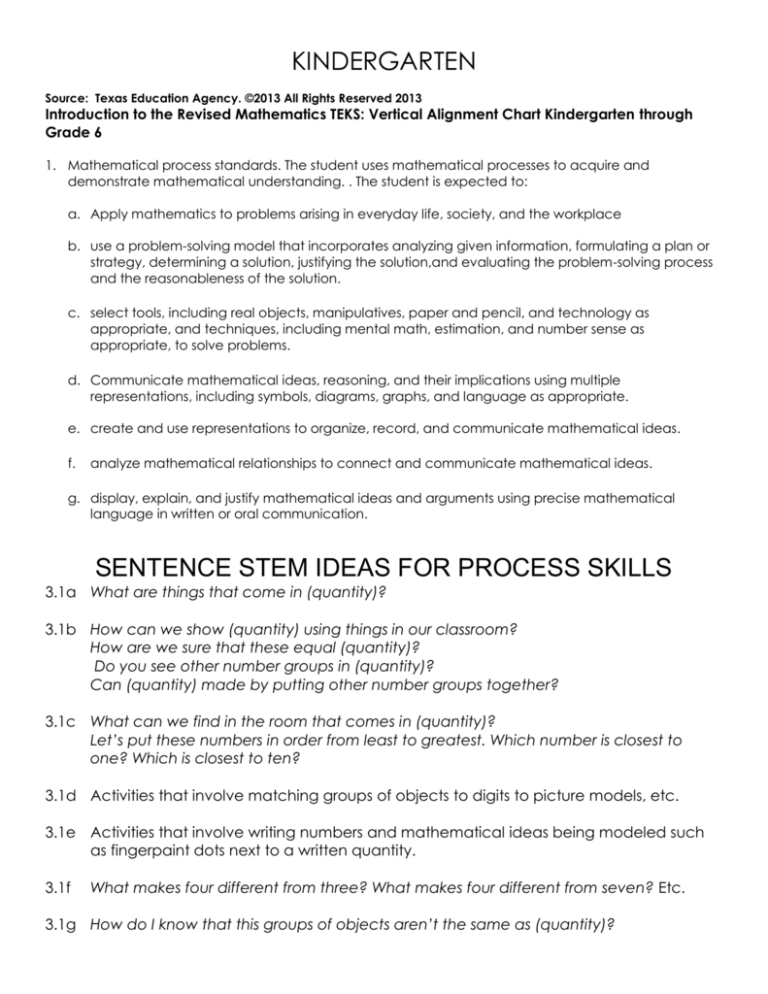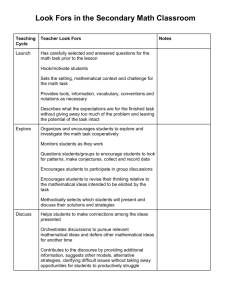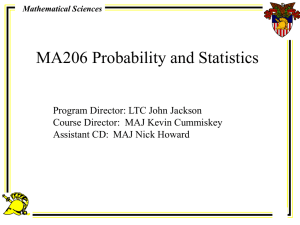
KINDERGARTEN
Source: Texas Education Agency. ©2013 All Rights Reserved 2013
Introduction to the Revised Mathematics TEKS: Vertical Alignment Chart Kindergarten through
Grade 6
1. Mathematical process standards. The student uses mathematical processes to acquire and
demonstrate mathematical understanding. . The student is expected to:
a. Apply mathematics to problems arising in everyday life, society, and the workplace
b. use a problem-solving model that incorporates analyzing given information, formulating a plan or
strategy, determining a solution, justifying the solution,and evaluating the problem-solving process
and the reasonableness of the solution.
c. select tools, including real objects, manipulatives, paper and pencil, and technology as
appropriate, and techniques, including mental math, estimation, and number sense as
appropriate, to solve problems.
d. Communicate mathematical ideas, reasoning, and their implications using multiple
representations, including symbols, diagrams, graphs, and language as appropriate.
e. create and use representations to organize, record, and communicate mathematical ideas.
f.
analyze mathematical relationships to connect and communicate mathematical ideas.
g. display, explain, and justify mathematical ideas and arguments using precise mathematical
language in written or oral communication.
SENTENCE STEM IDEAS FOR PROCESS SKILLS
3.1a What are things that come in (quantity)?
3.1b How can we show (quantity) using things in our classroom?
How are we sure that these equal (quantity)?
Do you see other number groups in (quantity)?
Can (quantity) made by putting other number groups together?
3.1c What can we find in the room that comes in (quantity)?
Let’s put these numbers in order from least to greatest. Which number is closest to
one? Which is closest to ten?
3.1d Activities that involve matching groups of objects to digits to picture models, etc.
3.1e Activities that involve writing numbers and mathematical ideas being modeled such
as fingerpaint dots next to a written quantity.
3.1f
What makes four different from three? What makes four different from seven? Etc.
3.1g How do I know that this groups of objects aren’t the same as (quantity)?
FIRST GRADE
Source: Texas Education Agency. ©2013 All Rights Reserved 2013
Introduction to the Revised Mathematics TEKS: Vertical Alignment Chart Kindergarten through
Grade 6
1. Mathematical process standards. The student uses mathematical processes to acquire and
demonstrate mathematical understanding. . The student is expected to:
a. Apply mathematics to problems arising in everyday life, society, and the workplace
b. use a problem-solving model that incorporates analyzing given information, formulating a plan or
strategy, determining a solution, justifying the solution,and evaluating the problem-solving process
and the reasonableness of the solution.
c. select tools, including real objects, manipulatives, paper and pencil, and technology as
appropriate, and techniques, including mental math, estimation, and number sense as
appropriate, to solve problems.
d. Communicate mathematical ideas, reasoning, and their implications using multiple
representations, including symbols, diagrams, graphs, and language as appropriate.
e. create and use representations to organize, record, and communicate mathematical ideas.
f.
analyze mathematical relationships to connect and communicate mathematical ideas.
g. display, explain, and justify mathematical ideas and arguments using precise mathematical
language in written or oral communication.
SENTENCE STEM IDEAS FOR PROCESS SKILLS
3.1a What are things that come in (quantity)?
Can you think of a time when you combined things? Tell me. Show me.
Can you think of a time when you compared what you had to what a friend has? Tell
me. Show me.
Have you ever had to share something fairly with your brother or sister? Tell me. Show
me.
3.1b (provide any word problem) What are we trying to find out in this problem?
What numbers do we know in the problem?
What do the numbers mean? What do they look like?
How do we use these numbers to solve our problem?
What are some other ways we could show our solution?
3.1c Which of these numbers is closest to one? Which is closest to twenty? To fifty? How do
we know?
Activities where the student estimates before counting, adding, or subtracting.
Activities where the student self-selects objects or drawings to represent solutions, then
pair-shares to compare strategy with peer.
3.1d Activities that involve matching groups of objects to digits to picture models, etc.
Activities where students match data to graphs or pictorial representations.
3.1e Table lessons where student matches invented solution to a solution sentence,
including related facts other than the traditional solution to provoke discussions.
EXAMPLE: Josue has fourteen bottle caps and Maria has twenty bottle caps. How
many more bottle caps does Maria have than Josue?
Traditional solution (do not give as answer option): 20 – 14 = 6
Possible answer options given:
20 – 6 = 14
6 + 14 = 20
14 + 6 = 20
3.1f
What makes twenty-two different from twenty -three? What makes fourteen different
from seventeen? Etc.
Activities such as daily number to brainstorm related facts and multistep problems.
3.1g How do I know that this groups of objects aren’t the same as (quantity)?
Math journal – representing word problems in multiple ways such as solution sentence,
picture, number line, base ten blocks, etc.
SECOND GRADE
Source: Texas Education Agency. ©2013 All Rights Reserved 2013
Introduction to the Revised Mathematics TEKS: Vertical Alignment Chart Kindergarten through
Grade 6
2. Mathematical process standards. The student uses mathematical processes to acquire and
demonstrate mathematical understanding. . The student is expected to:
a. Apply mathematics to problems arising in everyday life, society, and the workplace
b. use a problem-solving model that incorporates analyzing given information, formulating a plan or
strategy, determining a solution, justifying the solution,and evaluating the problem-solving process
and the reasonableness of the solution.
c. select tools, including real objects, manipulatives, paper and pencil, and technology as
appropriate, and techniques, including mental math, estimation, and number sense as
appropriate, to solve problems.
d. Communicate mathematical ideas, reasoning, and their implications using multiple
representations, including symbols, diagrams, graphs, and language as appropriate.
e. create and use representations to organize, record, and communicate mathematical ideas.
f.
analyze mathematical relationships to connect and communicate mathematical ideas.
g. display, explain, and justify mathematical ideas and arguments using precise mathematical
language in written or oral communication.
SENTENCE STEM IDEAS FOR PROCESS SKILLS
3.1a What are things that come in (quantity)?
Can you think of a time when you combined things? Tell me. Show me.
Can you think of a time when you compared what you had to what a friend has? Tell
me. Show me.
Have you ever had to share something fairly with your brother or sister? Tell me. Show
me.
3.1b (provide any word problem) What are we trying to find out in this problem?
What numbers do we know in the problem?
What do the numbers mean? What do they look like?
How do we use these numbers to solve our problem?
What are some other ways we could show our solution?
3.1c Which of these numbers is closest to zero? Which is closest to fifty? To one hundred?
How do we know?
Activities where the student estimates before counting, adding, or subtracting.
Activities where the student self-selects objects or drawings to represent solutions, then
pair-shares to compare strategy with peer.
3.1d Activities that involve matching groups of objects to digits to picture models, etc.
Activities where students match data to graphs or pictorial representations.
3.1e Table lessons where student matches invented solution to a solution sentence,
including related facts other than the traditional solution to provoke discussion.
EXAMPLE: Josue has fourteen bottle caps and Maria has twenty-four bottle caps.
How many more bottle caps does Maria have than Josue?
Traditional solution (do not give as answer option): 24 – 14 = 10
Possible answer options given:
24 – 10 = 14
10 + 14 = 24
14 + 10 = 24
3.1f
What makes twenty-four different from twenty -three? What makes fourteen different
from thirty-seven? Etc.
Activities such as daily number to brainstorm related facts and multistep problems.
3.1g How do I know that this groups of objects aren’t the same as (quantity)?
Math journal – representing word problems in multiple ways such as solution sentence,
picture, number line, base ten blocks, etc.
THIRD GRADE
Source: Texas Education Agency. ©2013 All Rights Reserved 2013
Introduction to the Revised Mathematics TEKS: Vertical Alignment Chart Kindergarten through
Grade 6
1. Mathematical process standards. The student uses mathematical processes to acquire and
demonstrate mathematical understanding. . The student is expected to:
a. Apply mathematics to problems arising in everyday life, society, and the workplace
b. use a problem-solving model that incorporates analyzing given information, formulating a plan or
strategy, determining a solution, justifying the solution,and evaluating the problem-solving process
and the reasonableness of the solution.
c. select tools, including real objects, manipulatives, paper and pencil, and technology as
appropriate, and techniques, including mental math, estimation, and number sense as
appropriate, to solve problems.
d. Communicate mathematical ideas, reasoning, and their implications using multiple
representations, including symbols, diagrams, graphs, and language as appropriate.
e. create and use representations to organize, record, and communicate mathematical ideas.
f.
analyze mathematical relationships to connect and communicate mathematical ideas.
g. display, explain, and justify mathematical ideas and arguments using precise mathematical
language in written or oral communication.
FOURTH GRADE
Source: Texas Education Agency. ©2013 All Rights Reserved 2013
Introduction to the Revised Mathematics TEKS: Vertical Alignment Chart Kindergarten through
Grade 6
1. Mathematical process standards. The student uses mathematical processes to acquire and
demonstrate mathematical understanding. . The student is expected to:
a. Apply mathematics to problems arising in everyday life, society, and the workplace
b. use a problem-solving model that incorporates analyzing given information, formulating a plan or
strategy, determining a solution, justifying the solution,and evaluating the problem-solving process
and the reasonableness of the solution.
c. select tools, including real objects, manipulatives, paper and pencil, and technology as
appropriate, and techniques, including mental math, estimation, and number sense as
appropriate, to solve problems.
d. Communicate mathematical ideas, reasoning, and their implications using multiple
representations, including symbols, diagrams, graphs, and language as appropriate.
e. create and use representations to organize, record, and communicate mathematical ideas.
f.
analyze mathematical relationships to connect and communicate mathematical ideas.
g. display, explain, and justify mathematical ideas and arguments using precise mathematical
language in written or oral communication.
FIFTH GRADE
Source: Texas Education Agency. ©2013 All Rights Reserved 2013
Introduction to the Revised Mathematics TEKS: Vertical Alignment Chart Kindergarten through
Grade 6
1. Mathematical process standards. The student uses mathematical processes to acquire and
demonstrate mathematical understanding. . The student is expected to:
a. Apply mathematics to problems arising in everyday life, society, and the workplace
b. use a problem-solving model that incorporates analyzing given information, formulating a plan or
strategy, determining a solution, justifying the solution,and evaluating the problem-solving process
and the reasonableness of the solution.
c. select tools, including real objects, manipulatives, paper and pencil, and technology as
appropriate, and techniques, including mental math, estimation, and number sense as
appropriate, to solve problems.
d. Communicate mathematical ideas, reasoning, and their implications using multiple
representations, including symbols, diagrams, graphs, and language as appropriate.
e. create and use representations to organize, record, and communicate mathematical ideas.
f.
analyze mathematical relationships to connect and communicate mathematical ideas.
g. display, explain, and justify mathematical ideas and arguments using precise mathematical
language in written or oral communication.
SIXTH GRADE
Source: Texas Education Agency. ©2013 All Rights Reserved 2013
Introduction to the Revised Mathematics TEKS: Vertical Alignment Chart Kindergarten through
Grade 6
1. Mathematical process standards. The student uses mathematical processes to acquire and
demonstrate mathematical understanding. . The student is expected to:
a. Apply mathematics to problems arising in everyday life, society, and the workplace
b. use a problem-solving model that incorporates analyzing given information, formulating a plan or
strategy, determining a solution, justifying the solution,and evaluating the problem-solving process
and the reasonableness of the solution.
c. select tools, including real objects, manipulatives, paper and pencil, and technology as
appropriate, and techniques, including mental math, estimation, and number sense as
appropriate, to solve problems.
d. Communicate mathematical ideas, reasoning, and their implications using multiple
representations, including symbols, diagrams, graphs, and language as appropriate.
e. create and use representations to organize, record, and communicate mathematical ideas.
f.
analyze mathematical relationships to connect and communicate mathematical ideas.
g. display, explain, and justify mathematical ideas and arguments using precise mathematical
language in written or oral communication.








